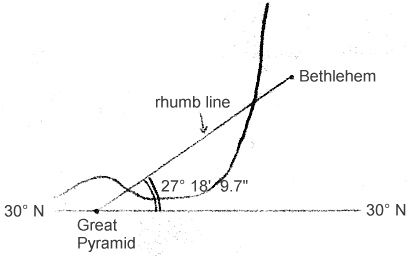
There is an interesting comparison to be drawn between the Authorship Problem and the Great Pyramid Problem.
Most people know that the plays of Shakespeare have been used to show that Francis Bacon was the ‘true’ author of the plays.
What is not commonly known is that these same plays have been made to yield evidence – carrying varying degrees of conviction – that no less than seventeen different authors ‘really wrote’ the plays commonly attributed to Shakespeare.
As one commentator put it, when the plays have ‘shown’ that much, then it is time to realise that they have really ‘shown’ nothing at all. The investigators have merely used the plays – a convenient passage here, another there – to reflect their own preconceived notions, which have usually had their origin in the conviction that the ‘country bumpkin’ Shakespeare could not possibly have written such great literature. (Such investigators, of course, are unwilling to accept that genius can assume some strange guises.)
Is there a fair comparison between anti-Shakespeareanism and Pyramidology?
Has the pyramid ‘shown’ too much, and thus proved nothing at all? Has the pyramid been used, like the Shakespearean plays – both offer ample material to juggle with, the one in words, the other in measurements – simply to reflect the academic delusions of their proponents? Do pyramid theories tell us more about their proponents than about the masonry of the pyramid itself?
Appended are the diagrams referred to in my Fortean Times article – plus two others. They are similar geometrical ideas concerning the location of the Great Pyramid, and to my mind they are striking in their similarity.
Elsewhere – under “Numerical Coincidences” in the present folio – I have touched upon the controversy over the Great Pyramid Face Angle. This angle, about 51° 51′ – does it indicate the squaring of the circle? Does it indicate a knowledge of the Martian Satellites [1]? Does it embody the Golden Mean? Does it indicate that the Egyptians used a rolling drum to measure out horizontal distances [2]? Or do its face edges simply rise 9 cubits vertically for every 10 horizontally?
Now these divergent schemes for this and that – they cannot all be right. The comic figure in my Fortean Times article of the three-eyed extra-terrestrial with one eye on Mars, one on Bethlehem, and one on Stonehenge, was an attempt to personify this.
The very divergence of such theories might only illustrate the fact that the Great Pyramid can be woven into any number of geometrical – or other – romances.
That these theories are romances, imposed on an innocent pyramid, would also explain the “psychological pyramidology” suggested in my Fortean Times article. If, like the Shakespeare plays, the Great Pyramid is a versatile enough ‘instrument’ to reflect the preconceived notions of its unwary investigators, then this would explain the changing ‘flavour’ of pyramidology, most recently seen in the transition from the nineteenth-century ‘Bible-in-Stone’ to the twentieth-century Space Beacon / Mars indicator.
| [1] | M. W. Saunders, Destiny Mars, p. 38. |
| [2] | K. Mendelssohn, The Riddle of the Pyramids, pp. 72–3 |
Notes on the figures:

| Fig. 1. | The Great Pyramid as a Bethlehem Indicator. A rhumb line, or line of constant bearing, starting at the Great Pyramid, and directed towards E 28° 18′ N, this being the angle of the pyramid’s passage system to the horizontal, passes directly through Bethlehem. Based on the diagram in Adam Rutherford’s Pyramidology, vol. 2, p. 343. |
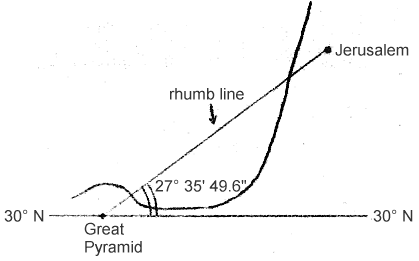
| Fig. 2. | The Great Pyramid as a Jerusalem Indicator. Again, the scheme uses a rhumb line (as opposed to a great circle), the marked angle being derived as in fig. 3 from a quadrature of the circle. |
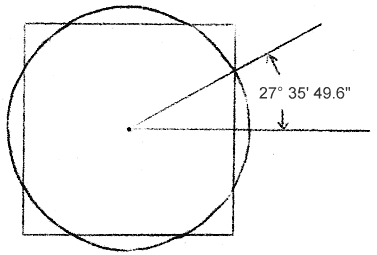
| Fig. 3. | The derivation of the angle in fig. 2 from a circle and a square which have equal area, the centre of the circle being at the intersection of the square’s diagonals. This and fig. 2 are based on illustrations in Adam Rutherford’s Pyramidology, vol. 2, pp. 474–5. |
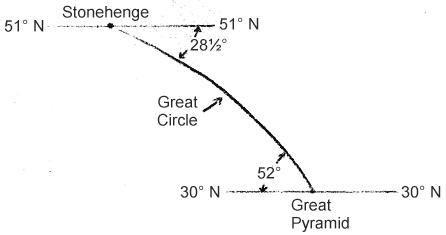
| Fig. 4. | Stuart Greenwood’s Giza–Stonehenge connection, based on the diagram in The News, issue 15, p. 14. (But see also his ‘Fortfest Article’ in the present folio.) |
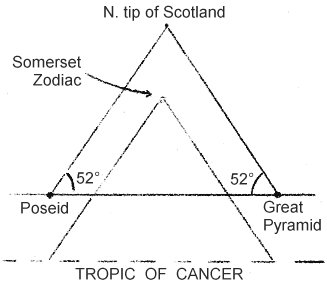
| Fig. 5. | Another use of the Great Circle, originating in the Great Pyramid and heading W 52° N, this time as part of an Atlantis Indicator. (Poseid is supposed to be the site of the last remnant of the old Atlantean Continent, now submerged beneath the Atlantic.) By letting the Poseid–Scotland–Great Pyramid triangle ‘slide southward’ so that its base lies on the Tropic of Cancer, it will be found, or so it is claimed, that the ‘peak’ of the triangle, formerly in Scotland, has ‘slid’ so as to occupy the site of the Somerset Zodiac. The scheme appears to have been derived by the use of a globe, a piece of string, and a transparent protractor – however, the diagram here is based on information contained in Brinsley Le Poer Trench’s book Temple of the Stars (Fontana, 1973), pp. 122 ff. |